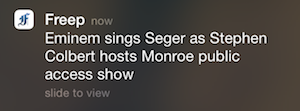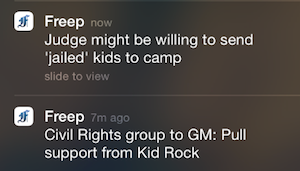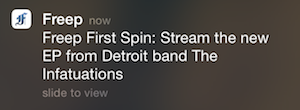
Editor’s note: This is the last in a series of stories on how news organizations manage their mobile news alerts. Each day this week, we looked at how The New York Times, Breaking News, CNN, The Wall Street Journal, and now the Detroit Free Press decide which news warrants a push notification, and learn about the process each goes through to send alerts out to their readers.
It’s been a frustrating season for Detroit Tigers fans. (Disclosure: I am one.) The team was supposed to compete for its fifth straight American League Central title, but the Tigers have a disappointing 55-59 record. They trail the first-place Kansas City Royals by 13 games, and at the trade deadline last month, the Tigers dealt away many of their best players to stock up on prospects for future seasons.
Even though those who follow the Tigers might want to tune out the team at this point, the Detroit Free Press is giving its mobile app users more baseball coverage than ever as it sends out push alerts to tease its baseball podcast, share important team news, and also give the score and details of games after they’re over. (It’ll send out more frequent alerts to users who are signed up for the Free Press’ sports alerts.)The increase in alerts is part of a larger strategy the Free Press has introduced this year to boost the frequency with which it sends alerts. In addition to breaking local and national news, the paper will send out alerts for things such as Stephen Colbert and Eminem appearing on a Michigan cable access television show.
I spoke with Ashley C. Woods, the Free Press’ director of consumer experience, who described the paper’s push alert strategy for me. Here’s a lightly edited and condensed transcript.
We changed to a new app and a new content management system last fall. We’ve increased the number of people on our desk who can send a breaking news alert, and it’s become a lot easier to do. It’s something that more people in the newsroom are feeling comfortable with.
We have what we call The Hub, which is where the people who work exclusively as digital producers, homepage editors, copy editors, and page designers sit. They’re all working in the same place, a desk in the middle of the newsroom. In the case of same-sex marriage, I sent that push alert out. We had prepped beforehand: Three different stories and three different headlines, based on how we thought the ruling might go. And we had a reporter in DC who was outside of the Supreme Court. As soon as he heard something, he called, narrated to me, I typed out the headline and hit send. Somebody then grabbed that content ID, put it into our push alert generator, and sent it. It all happened within 45 seconds.After that comes the breaking news email, then Facebook, and Twitter. And then updating the story. It’s like a little symphony.
The same technology allows us to create a banner on our desktop, mobile, and tablet sites at the same time. We have the immediate ability to reach out and touch people on their phones, and say, “Hey, look at this.” But then anyone who is on freep.com can see it, so it’s the easiest way to grab as many eyes as possible.
My boss, Robert Huschka, was the person in the newsroom who really was advocating to send more push alerts. [Ed. Note: Huschka was chosen as the Free Press’ full-time executive editor this week.] He couldn’t get enough.  He got an Apple Watch, and he loves getting the little alert on his watch. So he wants to send as many as possible.
He got an Apple Watch, and he loves getting the little alert on his watch. So he wants to send as many as possible. There was some pushback in the newsroom. People were worried that we were going to alienate readers, but to this day, we haven’t gotten a single complaint from anyone outside the newsroom that we are sending too many push alerts.
There was some pushback in the newsroom. People were worried that we were going to alienate readers, but to this day, we haven’t gotten a single complaint from anyone outside the newsroom that we are sending too many push alerts.
Before, if we were breaking the story, we would send the push alert. If it was of huge national consequence, we would send a push alert. If it was a court verdict, we would send a push alert. But we were hesitant in situations that didn’t meet those criteria. Now, we have extended it. We will do the Tigers lineup for everyone who has signed up for our sports alerts.  We have a feature called Freep First Spin, where we’re debuting exclusive tracks or videos from Detroit bands. We send a push alert around lunchtime for that. We never would have sent out a push alert about that before, but we think the push alert now isn’t just about giving you breaking news. It’s giving you content that we’re really proud of, that we want you to associate with us, something that’s very Free Press at this moment.
We have a feature called Freep First Spin, where we’re debuting exclusive tracks or videos from Detroit bands. We send a push alert around lunchtime for that. We never would have sent out a push alert about that before, but we think the push alert now isn’t just about giving you breaking news. It’s giving you content that we’re really proud of, that we want you to associate with us, something that’s very Free Press at this moment.